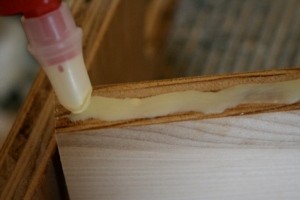Some woodworkers don’t spend much time thinking about adhesives until they don’t work. But finding out a little bit more about different types of adhesives makes sense for any woodworking enthusiast interested in making sure that projects finish right.
Animal glues. Once widely used by woodworkers, these traditional adhesives aren’t really used that much anymore. These glues must be heated in a glue pot before application. Reheating a project put together with animal hide glue allows you to readjust or remove parts. This also means that hide glues don’t resist heat. In addition, they have poor moisture resistance. Animal hide glues dry and cure slowly, so they need a long clamping time.
Resin glues.These woodworking glues are used a lot and are made with polyvinyls or aliphatic resins. They come in white, yellow, and brown varieties. They are premixed, so you apply them directly to the wood from their squeeze-type containers. Strong and somewhat fast-drying (about 3 hours clamp time). There are newer resin glues that offer extended water resistance. The white variety dries more slowly; the yellow and brown resist heat and moisture better. Resin glues can be used in a wide range of temperatures.
Epoxies and thermosetting glues.Urea-formaldehyde, resorcinol-formaldehyde, and epoxy offer strong, permanent, highly water-resistant joints, but they are expensive and require mixing. After they are mixed, a hardening chemical reaction begins, so you have to work quickly before the mixture sets up, especially in warm temperatures. They are effective for outdoor projects, but these adhesives can irritate your skin and eyes.
Specialty bonding agents. Woodworkers use contact cement to hold plastic laminate or veneer to wood surfaces. It’s applied to both surfaces and bonds immediately. Adjustments cannot be easily made, and the work area must be well ventilated. Cyanoacrylate glues are the so-called “super glues.” They display exceptional strength and quick bonding with nonporous materials. New polyurethane glues perform like epoxies, but with no mixing and fumes. They expand as they cure, filling any gaps in joints. They’re also waterproof.
So there you have it! A little extra information on finding the right adhesive for your projects!



